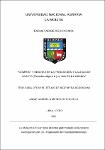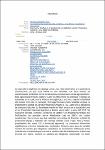Mostrar el registro sencillo del ítem
Compost y biochar en la producción y calidad de Vainita (Phaseolus vulgaris L.) cv. Jade en La Molina
| dc.contributor.advisor | Casas Díaz, Andrés Virgilio | |
| dc.contributor.author | Mendoza Tenicela, Angie Gabriela | |
| dc.date.accessioned | 2019-10-18T16:35:01Z | |
| dc.date.available | 2019-10-18T16:35:01Z | |
| dc.date.issued | 2019 | |
| dc.identifier.other | F04.M4558-T BAN UNALM | |
| dc.identifier.uri | https://hdl.handle.net/20.500.12996/4140 | |
| dc.description | Universidad Nacional Agraria La Molina. Facultad de Agronomía. Departamento Académico de Horticultura | es_PE |
| dc.description.abstract | La agricultura orgánica se cataloga como una mejor alternativa a la agricultura convencional, ya que esta última es una actividad con altos niveles de contaminación ambiental como consecuencia del excesivo uso de agroquímicos. Esta agricultura tiene por objetivo cubrir el déficit entre las entradas y salidas de nutrientes en el suelo con la fertilización orgánica, y a su vez mejorar la fertilidad del mismo. Por ello, la presente investigación tuvo como finalidad evaluar la producción y calidad de vainita (Phaseolus vulgaris L.) cv. Jade con la aplicación de compost y biochar. La fase experimental se llevó a cabo en la ciudad de Lima en la Universidad Nacional Agraria La Molina, entre marzo y junio del 2018. Se evaluaron biochar, compost, la mezcla de ambos y el tratamiento testigo (sin fertilización), las parcelas fueron distribuidas bajo un DBCA con cuatro repeticiones. Se concluye que las variables: porcentaje de floración, calidad de producción (largo y diámetro de vainita), materia seca (hojas, tallo y fruto), propiedades del suelo (CE y densidad aparente), no presentan diferencias significativas entre los tratamientos empleados. Mientras que, para la variable número de vainitas por kilogramo cosechado se encontraron diferencias entre tratamientos únicamente para la cuarta cosecha, donde el tratamiento 2 (biochar) termina con mayor número de vainitas por kilogramo cosechado, es decir, vainitas de menor tamaño. La variable rendimiento total del cultivo presentó diferencias estadísticas entre los tratamientos, siendo el tratamiento 3 (compost) de menor rendimiento (6.2 Mg ha-1) comparado estadísticamente con el tratamiento testigo, 2 (biochar) y 4 (biochar + compost), de los cuales el tratamiento 4 resaltó entre los tres obteniendo 10.1 Mg ha-1. De las propiedades del suelo, el pH obtuvo diferencias significativas entre las evaluaciones, donde se aprecia que el tratamiento 2 (biochar) fue quien tuvo mayor tendencia de cambio en su valor. | es_PE |
| dc.description.abstract | Organic agriculture is cataloged as a better alternative to conventional agriculture, since the latter is an activity that causes high environmental contamination because of the excessive use of agrochemicals. This agriculture aims to cover the deficit between the inputs and outputs of nutrients in the soil with organic fertilization, and also manages to improve soil fertility. Therefore, the objective of this research was to evaluate the production and quality of vainita (Phaseolus vulgaris L.) cv. Jade with the application of biochar and compost. The experimental phase was carried out in the city of Lima at Universidad Nacional La Molina, between March and June of 2018. The treatments consisted in the application of biochar, compost, the mixture of both and the control treatment (without fertilization), the plots were distributed under a CRD with four replications. The following variables did not show significant differences between the treatments used: percentage of flowering, quality of production, dry matter (leaves, stem and fruit), soil properties (EC and apparent density). While, for the variable “number of pods per kilogram harvested”, differences were found between treatments only in the fourth harvest, where treatment two (biochar) ends with a greater number of pods per kilogram harvested; that is, smaller vainitas. The variable “total yield of the crop” showed differences between the treatments, being the treatment 3 (compost) the lowest yield (6.2 Mg ha-1) compared statistically with the control treatment, 2 (biochar) and 4 (biochar + compost), where treatment 4 stood out among the three obtaining 10.1 Mg ha-1. Among soil properties, the pH obtained significant differences between evaluations, where treatment 2 (biochar) was the one that had the greatest tendency to change its value. | en_US |
| dc.format | application/pdf | en_US |
| dc.language.iso | spa | es_PE |
| dc.publisher | Universidad Nacional Agraria La Molina | es_PE |
| dc.rights | info:eu-repo/semantics/openAccess | en_US |
| dc.rights.uri | https://creativecommons.org/licenses/by-nc-nd/4.0/ | * |
| dc.subject | Phaseolus vulgaris | es_PE |
| dc.subject | Variedades | es_PE |
| dc.subject | Carbon activado | es_PE |
| dc.subject | Coimpost | es_PE |
| dc.subject | Abonos orgánicos | es_PE |
| dc.subject | Dosis de aplicación | es_PE |
| dc.subject | Efectos de dosidificación | es_PE |
| dc.subject | Evaluación | es_PE |
| dc.subject | Rendimiento de cultivos | es_PE |
| dc.subject | Condición de la planta | es_PE |
| dc.subject | Propiedades físico-químicas suelo | es_PE |
| dc.subject | Perú | es_PE |
| dc.subject | Vainita vr. Jade | es_PE |
| dc.subject | Biochar | es_PE |
| dc.subject | La Molina (dist) | es_PE |
| dc.title | Compost y biochar en la producción y calidad de Vainita (Phaseolus vulgaris L.) cv. Jade en La Molina | es_PE |
| dc.type | info:eu-repo/semantics/bachelorThesis | en_US |
| thesis.degree.discipline | Agronomía | es_PE |
| thesis.degree.grantor | Universidad Nacional Agraria La Molina. Facultad de Agronomía | es_PE |
| thesis.degree.name | Ingeniero Agrónomo | es_PE |
| dc.subject.ocde | http://purl.org/pe-repo/ocde/ford#4.01.05 | es_PE |
| renati.author.dni | 74768840 | es_PE |
| dc.publisher.country | PE | es_PE |
| dc.type.version | info:eu-repo/semantics/publishedVersion | en_US |
| renati.advisor.orcid | https://orcid.org/0000-0001-7461-3924 | es_PE |
| renati.advisor.dni | 25540691 | es_PE |
| renati.type | https://purl.org/pe-repo/renati/type#tesis | es_PE |
| renati.level | https://purl.org/pe-repo/renati/level#tituloProfesional | es_PE |
| renati.discipline | 811036 | es_PE |
| renati.juror | Loli Figueroa, Oscar Oswaldo | |
| renati.juror | Coronado Matutti, Karin Cecilia | |
| renati.juror | Moreno Llacza, Sarita Maruja |
Ficheros en el ítem
Este ítem aparece en la(s) siguiente(s) colección(ones)
-
AGR-HO Tesis [244]




